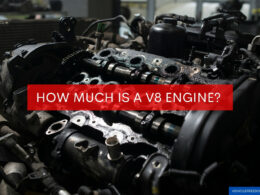In This Article Show
When you’ve been a mechanic for over 13 years, like I have, you come across many car sounds—some good, others worrying. There are many sounds or noises to be concerned about, like whirring sounds, squeaking, and others But the moment there’s discord, like a jarring squeal on a cold start, it’s cause for concern.
Understanding these noises, especially from your vehicle, is essential. Not only for the car’s health but also for the safety of its passengers.
In my years of experience, I’ve learned that the sooner these issues are addressed, the better. And that’s what prompted me to not only fix cars but also to write about them. Let’s jump in.
Understanding the Squeal
One joy of working as a mechanic for over a decade is the ability to ‘listen’ to a car. Like a doctor might listen to your heart or lungs, mechanics lend their ears to the symphony of engines, brakes, and belts. But what is this squeal we often hear on a cold start? And why should it concern you?
What is a cold start?
A cold start refers to starting an engine that has not been running for a while, typically overnight. In colder climates or during the winter months, the term takes on a more literal meaning when the vehicle starts in chilly conditions.
During a cold start, the engine oil is thick, and the parts haven’t been lubricated for hours. This can sometimes lead to increased friction between components, producing that signature squeal.
The nature of squealing sounds: transient vs. consistent
Squeals can be short, lasting only a few seconds, or consistent, persisting for minutes or even throughout a drive. Transient squeals often arise from initial friction but can be just as concerning as consistent ones.
Consistent squeals can indicate a more persistent problem, like a part wearing out that needs urgent attention.
Importance of addressing the squeal promptly
Here’s a piece of wisdom from my 13 years in the field: cars ‘communicate’ for a reason. If your vehicle squeals, it’s trying to tell you something, and it’s vital not to ignore it.
A squeal might start as a minor inconvenience, but it can signal an impending breakdown or a safety hazard. Addressing it promptly saves future repair costs and ensures a safer driving experience.

Common Causes of Car Squealing on Cold Start
Each car has its quirks, its distinct rumbles, roars, and purrs. However, a squeal, especially during a cold start, isn’t one you’d list under ‘charming quirks’. It’s a signal, a warning. I’ve diagnosed countless cars with this symptom, and several common causes repeatedly emerge.
1. Belt Issues
Worn or loose serpentine belt: The serpentine belt drives several devices in an engine, such as the alternator, power steering pump, and air conditioning compressor. Over time, wear and tear can loosen or damage it. This can lead to a squealing sound, particularly on cold starts when the belt’s material is less flexible.
- Misaligned pulley: If a pulley is misaligned, it can cause uneven wear or make the belt slip, causing that distinct squeal.
- Stiffness in the belt due to cold temperatures: Cold can make rubber belts less pliable. This stiffness might produce a temporary squeal when starting in cold conditions until the belt warms up and regains flexibility.
2. Power Steering Pump
- Low power steering fluid: The power steering system is hydraulic, relying on fluid to operate smoothly. Low fluid levels can introduce air into the system, causing a squealing sound when turning the wheel, especially during a cold start.
- Worn-out pump: A failing power steering pump can cause a high-pitched noise. Regular checks can prevent total pump failure and the associated costs.
3. Brake Issues
- Rust on brake rotors: Overnight moisture can lead to a thin layer of rust on the brake rotors. When you first drive and apply brakes, the brake pads scrape this rust off, leading to a squealing sound.
- Worn brake pads or shoes: The squealing might be the built-in brake pad wear indicator, a metal scraper that touches the brake rotor when the pad material is almost gone.

4. Alternator Bearings
If the bearings in the alternator begin to wear out, they can produce a squealing noise. Over time, if left unattended, this could lead to alternator failure.
5. Water Pump Malfunctions
The water pump circulates coolant throughout the engine. A malfunctioning or failing water pump can emit a squeal, indicating its bearings are worn out.
6. Refrigerant Compressor Activation (for cars with air conditioning)
Activating the AC on a cold start can sometimes cause a brief squeal, especially if there’s an issue with the compressor or its belt.
Diagnosing the Issue
Identifying that there’s a problem is one thing, but pinpointing the exact cause is an entirely different challenge. Proper diagnosis is crucial because it helps you understand what’s going wrong and guides the necessary corrective actions.
So, how do we diagnose the source of that pesky squeal during a cold start?
1. Visual Inspection
Start with the basics. Pop the hood and visually inspect the belts for signs of wear, cracks, or looseness. Check the fluid reservoirs, especially the power steering fluid, for appropriate levels. Often, the problem is apparent just by looking.
2. Auditory Inspection
Engage your ears. Start the car and try to locate the source of the squeal. Is it more pronounced near the alternator? The power steering pump? Close listening can often narrow down the potential culprits.
3. Using a Mechanic’s Stethoscope
For those noises that are a bit more elusive, a mechanic’s stethoscope can be invaluable. It helps to amplify and isolate sounds, making it easier to pinpoint their origin. While common in professional garages, this tool can also be a useful addition to any DIYer’s toolkit.
4. Temporary Solutions (like belt dressings) and Why They Might Not be Ideal
Sometimes, in a bid to quickly silence the squeal, people turn to temporary solutions like belt dressings. While these might offer immediate relief, they often mask the underlying problem rather than resolve it.
They can also lead to additional residue and buildup, causing further complications.
Fixes for Car Squealing on Cold Start
Once you’ve successfully identified the culprit behind the squeal, it’s time to roll up those sleeves and dive into the fixes. While some solutions are straightforward and can be tackled by the average DIY enthusiast, others might require professional intervention.
Here’s a breakdown of potential fixes based on the diagnosed problem:
1. Belt Solutions
Replacing a worn or damaged belt: If your belt shows signs of wear or damage, it’s time for a replacement. Ensure you pick the right size and type for your vehicle.
Properly aligning pulleys: Misaligned pulleys can be the result of normal wear or after a repair. Using a straightedge or a laser alignment tool can help ensure the pulleys are correctly aligned.
Ensuring appropriate belt tension: An over-tightened belt can wear quickly and strain the components it drives, while a loose belt can slip. Adjust the tension as per the manufacturer’s recommendations.
2. Power Steering Fixes
Topping up or replacing power steering fluid: Refill with the correct fluid type if you’ve diagnosed low fluid levels. If the fluid appears dirty, consider a complete flush and refill.
Considering a pump replacement: If the power steering pump is the issue, it might be time for a replacement. While this is a task some experienced DIYers can tackle, others might prefer professional assistance.
3. Addressing Brake Issues
Cleaning rust off brake rotors: A gentle drive, applying brakes moderately, should naturally wear off any superficial rust. If the issue persists, consider a professional cleaning.
Replacing brake pads or shoes: If you’ve diagnosed worn-out brake pads or shoes, they must be replaced promptly. Remember to always change them in pairs (both front and rear) to ensure even braking.
4. Alternator and Water Pump
Considering replacements or repairs as necessary: The most effective solution is often a replacement for worn-out alternator bearings or malfunctioning water pumps. Ensure to use quality parts that are compatible with your vehicle.
4.5. Refrigerant Compressor
Consulting a specialist: If the issue lies with the AC’s refrigerant compressor, it might be wise to consult with a specialist. The air conditioning system is complex, and improper fixes can lead to more significant problems.
Preventative Measures to Avoid Car Squealing on Cold Start
A wise person once said, “An ounce of prevention is worth a pound of cure.” This principle rings especially true when it comes to car maintenance. To avoid the unnerving experience of a car squeal during those cold starts, consider the following preventative measures:
1. Regular Inspections
Belt checks: Every few months, visually inspect the serpentine and other belts for signs of wear, cracks, or looseness. Early detection can prevent unexpected breakages.
Fluid levels: Make it a routine to check various fluid levels, including the power steering fluid, oil, and coolant. Top up as needed and consider replacing fluids at recommended intervals.
2. Seasonal Preparations
Winter-proofing: If you live in a colder climate, consider using winter-grade lubricants and engine oils that remain more fluid at low temperatures. Also, storing your car in a garage or a warmer place can mitigate cold start issues.
3. Regular Maintenance
Scheduled services: Adhering to your car’s recommended service schedule ensures that various components are inspected, adjusted, and replaced as necessary. This regular checkup can nip potential problems in the bud.
Brake maintenance: Get your brakes checked at regular intervals. This will help identify worn-out pads or rotors and address them before they start squealing.
4. Quality Replacement Parts
Avoid cheap alternatives: While it might be tempting to save money with cheaper parts, these can often wear out faster and may not provide optimal performance. Always opt for reputable brands and, if possible, OEM (Original Equipment Manufacturer) parts.
5. Stay Educated
Know your car: Familiarize yourself with your car’s sounds and behaviors. Recognizing when something sounds off can help you address issues before they exacerbate.
Stay updated: Automotive technologies and best practices evolve. Read manuals, watch tutorials, or even join car forums to stay updated on the best care techniques for your vehicle.












